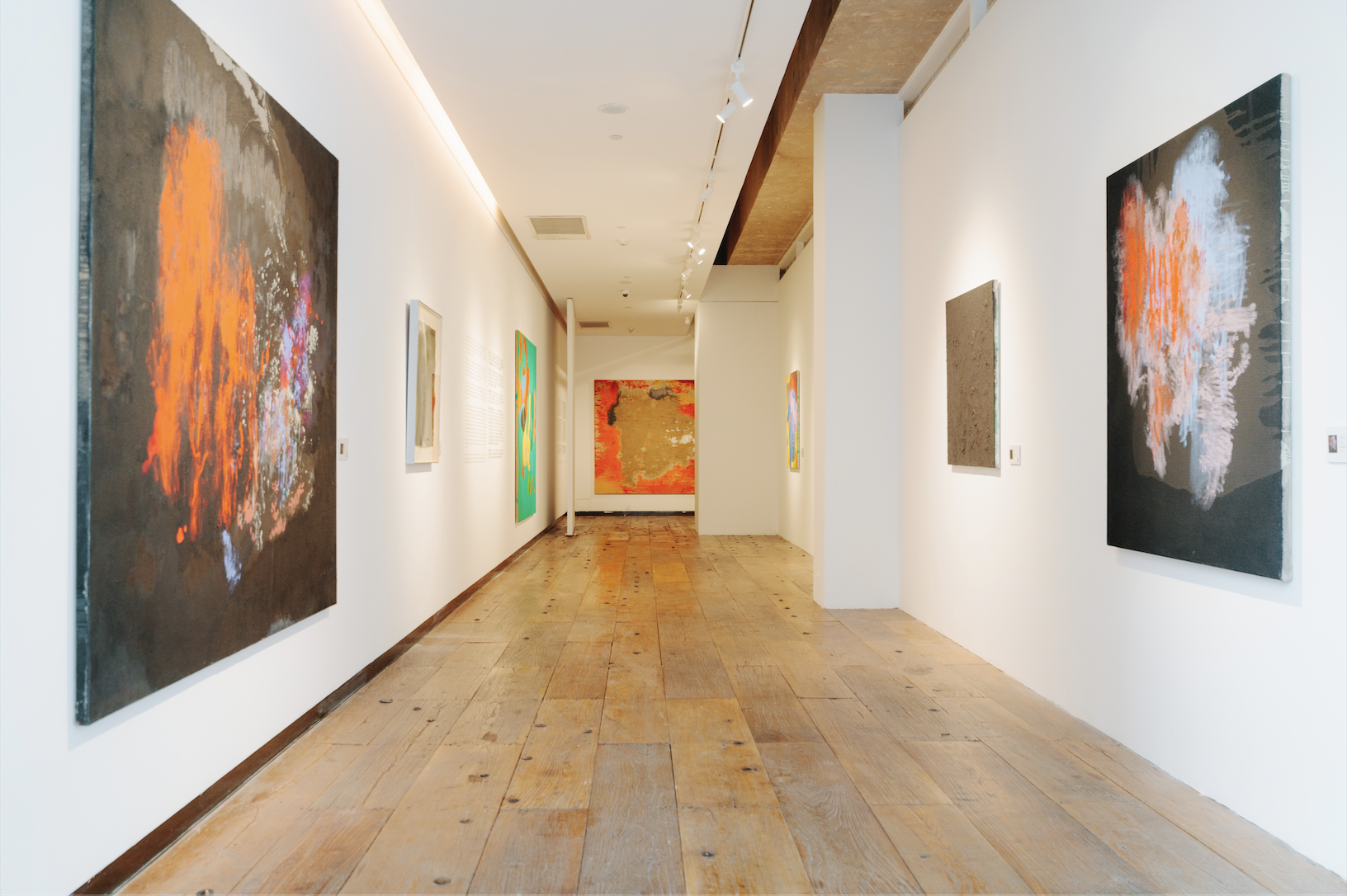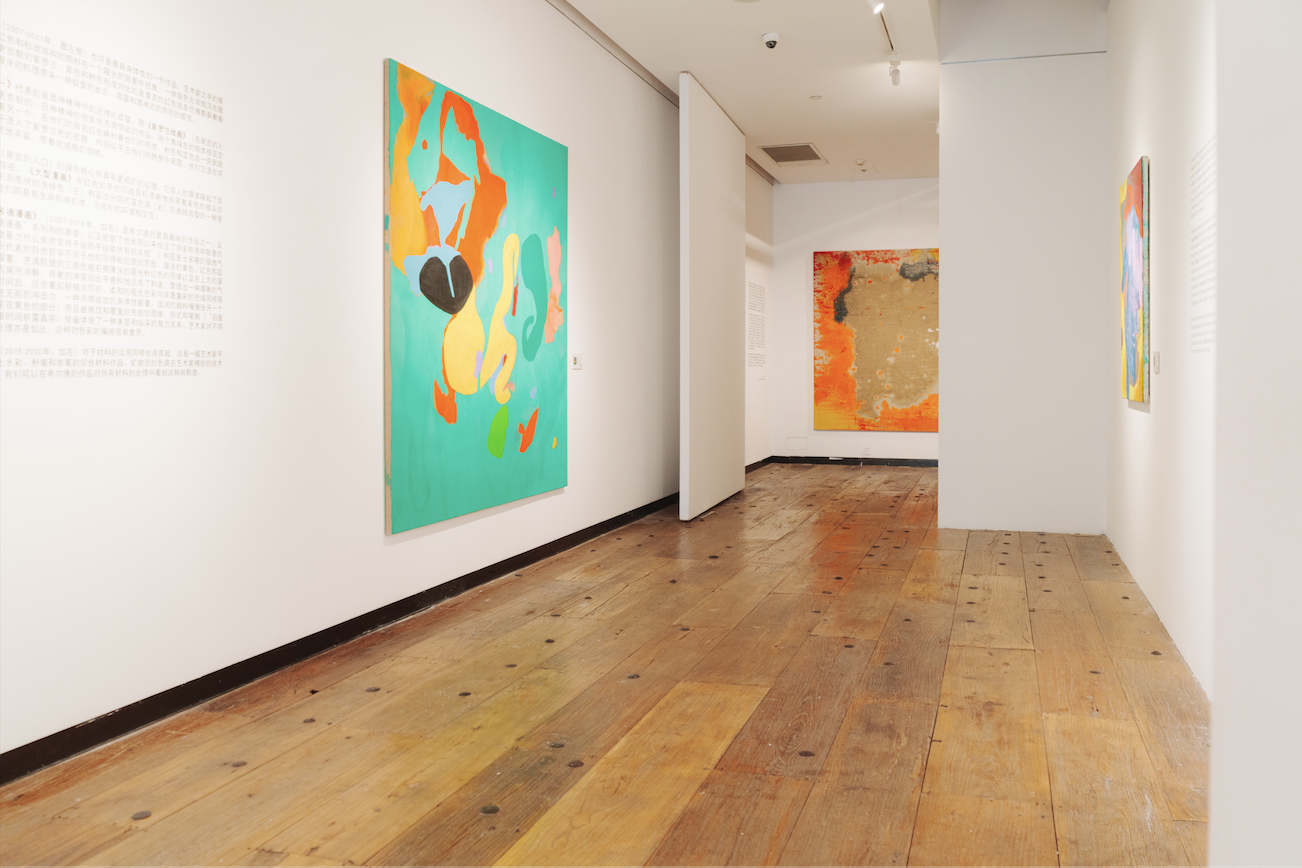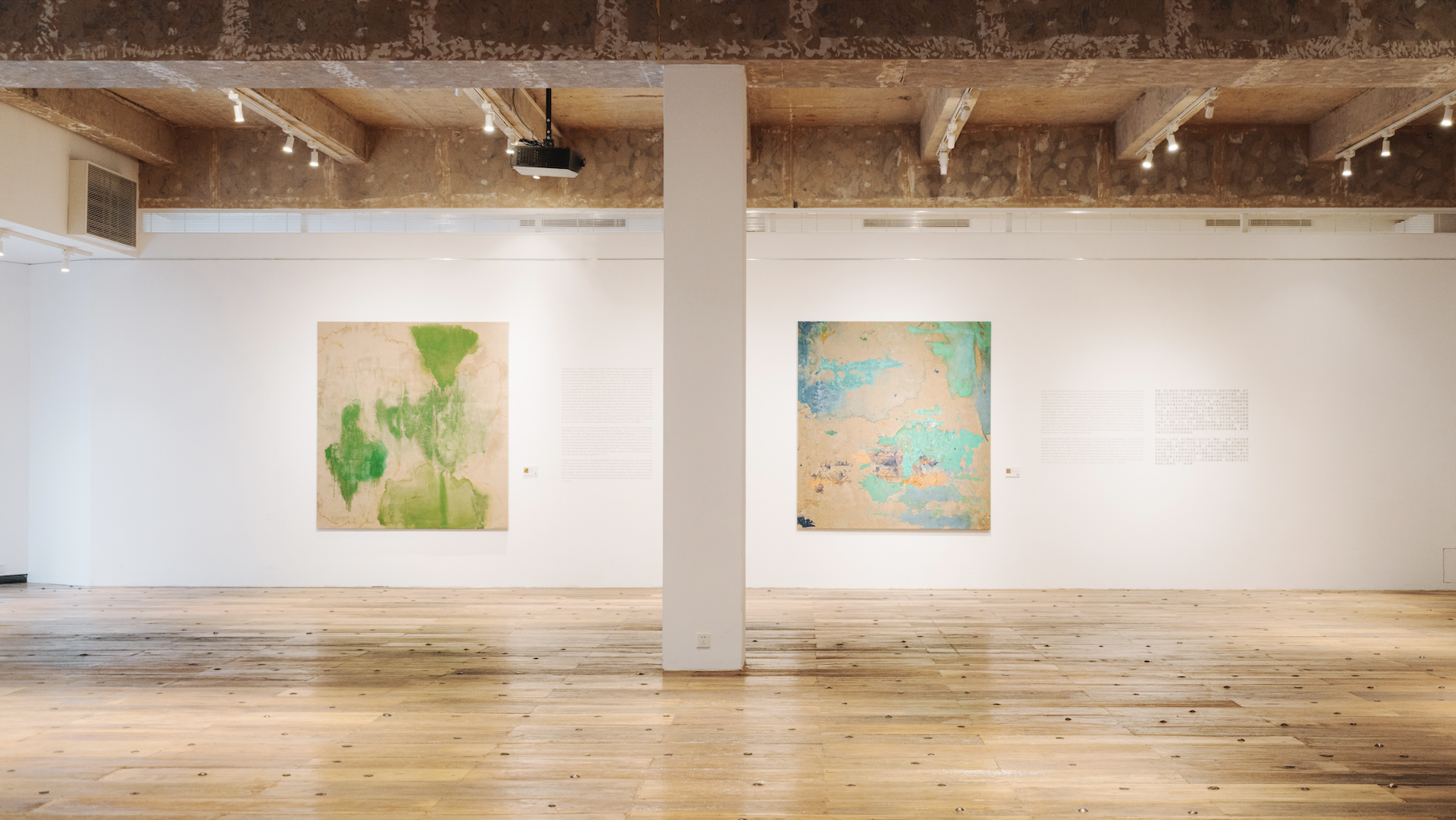‘THE MUSIC OF PURE ABSTRACTION’ AT CHAO ART CENTER
SOLO EXHIBITION OF THE RESPECTED AUSTRALIAN PAINTER, CHARLIE SHEARD
The image is more than an idea. It is a vortex or cluster of fused ideas and it is endowed with energy.
— Ezra Pound
Evoking Gestalt theory where the ‘configured whole’ is greater than its parts, by 2021 Sheard had completed works begun as early as the turn of the millennium and these, more orchestral in nature, a coming together of “movements” over an impressive span of time. Like musical phrases that only make sense when heard together, there is a greater relational exchange between the elements in the artist’s new work. There is still Sheard’s characteristic impossibility to trace process – so complex is the layering – and the most recently completed works signal an even more intense focus on bodily energy, on sensual forms and surfaces, and on the nature or being of painting itself so that the body is the ongoing process: “All of the focus of my artistic sensibility since 2020 is on the sensation of the body, my own and that of my models”.
Now the viewer can trace the artist’s hand itself, imprinted on the support, often in bloody red and isolated, as it is with Large Manga (2006-2021) and Violet Painting (2000-2021). Elsewhere the visceral quality to the direct bodily gesture and its imprint emanates from most of the support, and, as if going back to the beginning, these titles are Painting 1 (2007-2021) and Study 1 (2017-2021). In Study 1, the surface layers of which are entirely applied with fingers, horizontal fleshy tones grapple against the vertical cherry red and a deceptively innocent blue, as if clawing their way out of a darkened, claustrophobic chamber, reminiscent of the energy and dynamic of a Francis Bacon figure in space, shown page 25 of the book accompanying this exhibition, The Music of Pure Abstraction. For Sheard, Bacon’s work “is a space where an event happens” and by these horizontal clawing marks alone, the same as those rendered in purple in Painting 4 (2006-2021), to your left, conjures also a sense of Bacon’s high drama within a confined space.
Brushes and knives are used to intense dramatic effect in a new group simply titled Black Paintings, Sheard confided that he painted as if blind, bringing to mind a quote from the artist: “Made in the dark, Paleolithic cave painting, such as Lascaux and Chauvet, that I have particularly studied, the sense of touch is paramount”. Rendered entirely in black oil and acrylic on linen, Black Painting 1 (2006-2021), possesses an impasto so heavily encrusted it is on the verge of being under the skin.
Painting 1 (2007-2021) is perhaps the most carnal of all the works shown in this exhibition, all hands and an explosion of red, the grainy structure of the pigment in a largely matte work with, at top, the only luster of a silver release. In heightened contrast to more whimsical violets, purples and pinks, the vertical lacerations in red over and over and their building of impasto give a sense of licentious sensual, spontaneous desire and Dionysus.
If Painting 1 is Dionysian, unbridled desires, Violet Painting is an altogether more mannered, Apollonian, if still highly erotic work. Two turquoise figures entwine, one lifting the other up, their imprint of passion in red behind them, along with a short turn of a dance in polite pink and blue. Their night transitions to violet as time is seemingly suspended with their embrace and they luxuriate in a heavy purple, its texture rich and with the exquisiteness of velvet.
Of more rugged texture is the green core of Large Manga, its impasto so deep to evoke corporeality within nature. The red imprint of hands of Large Manga unambiguously seeking purple fingertips are musical accompaniment to the curvaceous forms, in light, feathery green (at canvas left) and a vital combination of blue spectra (at canvas right). It is us as interacting living organisms and our environment.
One of the most playful of Sheard’s works is Berserk Aristotle Manga (2007-2018), a reference to his love of the Berserk manga series and his ongoing interest in and respect for the quotidian aspect to Japanese manga (“hand drawing that is still made and related to for this reason today”) and Aristotle, representing nature, versus the intellectual thought of his teacher, Plato. The heavy, textured impasto of the yellows, reds, and blue oils, is unexpectedly comfortable given the powerful choice of prime colours is defused by a lighter application in pink matte acrylic, right, and opal orange acrylic, top left, both of which give an ethereal quality. Over time, these gentle, matte areas prove equally brave in their understatement as the areas of heavy impasto with their overt bodily energy. The incisions into wet paint, particularly into the yellow, and moreover, the presence or emergence of earlier images, forms and strokes that have been changed and painted over (‘pentimento’) also become apparent over time. The painting is a play with surface and depth, such is its handling of varying degrees of saturation, playful in its arrangement of colours.
Equally a masterclass in materiality is Pure Abstraction (2015-2020), a mixed material work in watercolour, pastel and charcoal on cotton paper handmade by the artist. Mineral hues are handled with the deftness we would expect from Sheard across every material in this delicate, yet earthy work.
The interplay of content and void in Sheard’s work, of equal importance in Chinese shan shui custom, is also apparent in the Abstraction (2017 – 2018). Initially, the movement, from right to left, appears to be predominantly on the work’s periphery, with the core of the work basking in the naturalness of raw linen with flickering patches of isolated white. Yet, over time, the movement also becomes apparent as emanating from the support itself; specifically from the support’s reverse, revealing what appears to be blue, an optical illusion brought about by simultaneous contrast of colour with the orange (it is actually black). Upon inspection of the verso, the surprise is an inside-out reflexiveness – a glowing, intense vermillion, under which lies the black. The meditative nature of shan shui that harks back a millennium and is still taught to this day in The Central Academy of Fine Art, as in every academy across China, is of particular interest to this Pure Abstractionist and Distinguished Mentor at CAFA.
Artist Charlie Sheard has absorbed a breathtaking range of artistic influences from across the globe and ages as if mankind’s myriad needs for expression and communication is to him one breath in a meditation on abstraction. As an artist seeking holistic depth, not just in terms of practice, but self-cultivation, the Classical shan shui landscape and Buddhist cave paintings of Dunhuang have held particular fascination to Sheard: specifically, the purist literati of the Song Dynasty who created subdued, contemplative, largely black and white, but also ‘Blue and Green’, mountain landscapes, and, in stark contrast, the polychromatic, transportive Buddhist frescoes of the Mogao Caves. The connection to each is not a superficial matter of colouration and form for Sheard; this is a deeper immersion into the capacity for both traditions to expand self, and therefore the language of Abstraction: “My approach as an artist is to work with intuition, moods, states, visions, emotions, bodily experience; I am interested in the direct transmission of these elements, and these are also the levels at which I respond most meaningfully to other works of art.” Both the landscapes that inspired shan shui and the caves of Dunhuang are also very much anchored in the energy of the places they are situated, for which conceptual discussion cannot replace physical encounter.
Over the past twenty years, Sheard has made numerous cultural ‘pilgrimages’ to the heartland of each tradition; further, and rarer still, as a non-Chinese artist, Sheard has been a Distinguished Mentor at one of the country’s most prestigious academic institutions in Beijing, The Central Academy of Fine Art, where he has become familiar with ink painters and scholars on the subjects. With the wonder of an outsider’s perspective (and especially an outsider with little appetite for affectation), the melding of tradition with the quotidian, that is brush and ink in the practice of calligraphy, while at the same time being part of a hallowed tradition of ink brush painting, “means that the Chinese viewer is closer to painting than most Western viewers who have never held a brush, certainly not as a regular or daily practice.” (Sheard)
Suspension of reality in floating forms is also a key aspect of shan shui landscape painting that produces a particular magic for the viewer. So too the equal importance given to content as the mysterious void. Colour was sometimes seen as unnecessary to producing a work of art that was meant to convey an intellectual idea and feeling. Most literati painters worked exclusively in black ink, referring to the Daode Jing: ‘the five colours blind the eye. The five tones deafen the ear. The five flavors dull the mouth.’ Furthermore, by using just black ink, the connection with calligraphy was further strengthened. Indeed, literati paintings were described in Chinese as not being ‘painted’ (hua, 畫 ) but ‘written’ (xie, 寫 ). Yet, the attraction of colour could not be entirely denied, no matter how much some literati scholars tried. Blue-green shan shui – a branch of landscape painting that uses predominantly blue and green pigments – emerged from the Tang dynasty (with the influence of the Dunhuang caves) and was first formulated by Li Sixun. In time, blue-green colours were used as allusions to the distant past or to paradisiacal realms in landscapes. The brightly coloured pigments incorporated minerals that were also used in alchemical practices searching for an elixir of immortality. Beyond a representation of the natural world, therefore, the paintings also embodied the magical properties associated with the imagined realms of the immortals. Indeed, to this day, a beautiful landscape is described in Chinese as having ‘blue mountains and green waters’ (qing shan lv shui, 青山綠水).
An aesthetic path from Dunhuang to shan shui also lies in Sheard’s larger scale Chinese Paintings, connected in concept and palette to the Blue – Green landscape tradition and in terms also of layering, such as Sheard’s Chinese Painting 2. Again, using much heavier materials such as acrylic, size (referring to the gelatinous substance), vinyl and pastel on raw linen, Sheard is able to evoke the ‘sea of clouds’ into a work he patiently revisited over the course of a staggering twenty-one years. It is the contemporary artist’s reply to Wang Ximeng’s A Thousand Miles of River and Mountain of the Northern Song Dynasty (960-1127): one of the largest paintings in Chinese history, being a silk scroll just under twelve meters in length, and completed when the artist was only eighteen in 1113.
A highly restrained work, Chinese Painting 1 through only pigmented acrylic on raw linen, renounces all blue for pure green, floating forms and faded sandy hues evoking stones as if suspended. In doing so, Sheard pays tribute to the same misty quality of blurred forms and hazy boundaries of the finest of Song landscape paintings as epitomized in another monumental landscape, Early Spring by Guo Xi (1020-1090), a pioneer of floating perspective (also known as ‘the angle of totality’), a technique that displaces the static eye of the viewer and further adds to the grandeur of nature.


